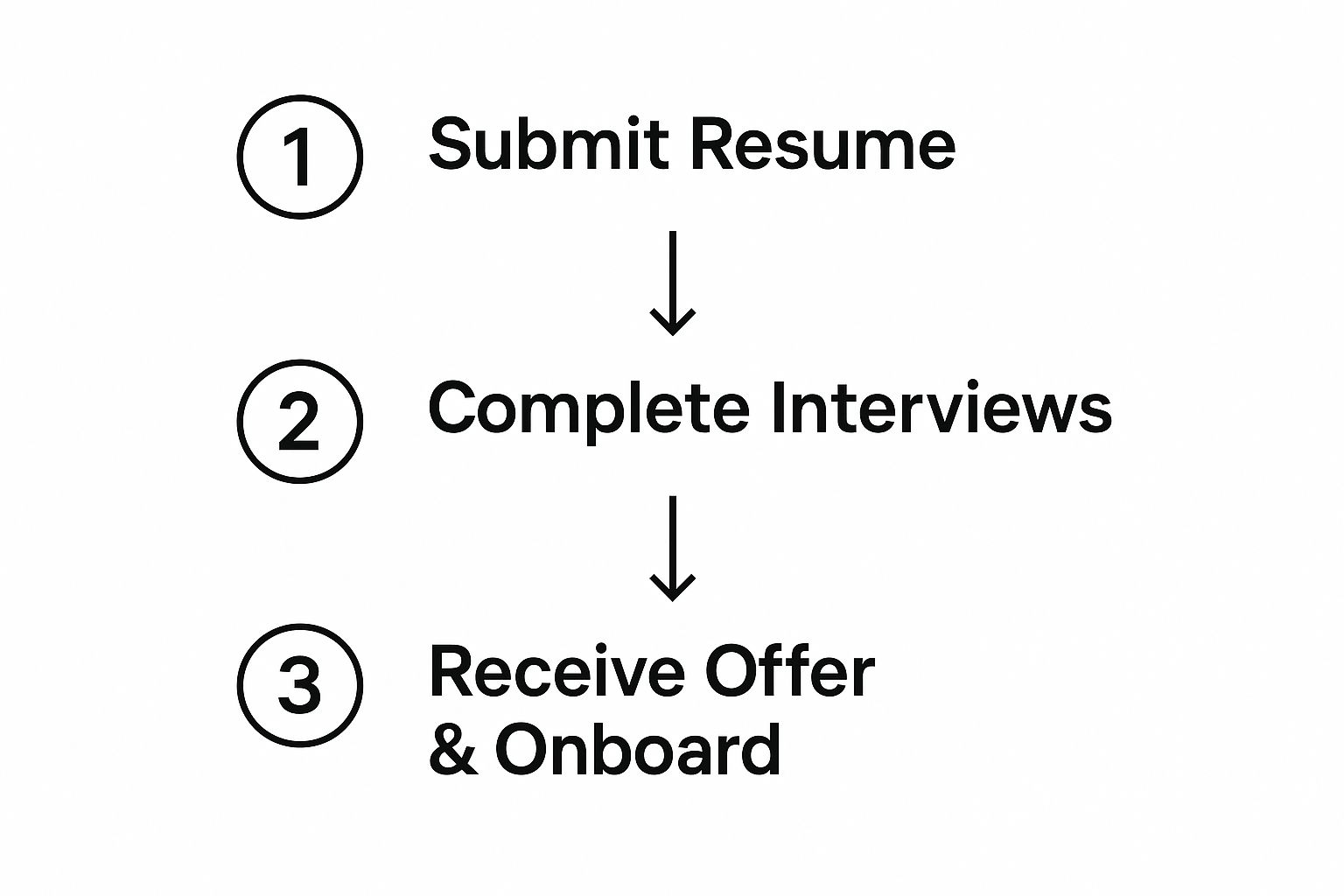Director of Sales Job Description That Attracts Talent
- Janis Kolomenskis
- Jul 27
- 13 min read
Let's be real for a moment. That generic Director of Sales job description you have saved on your desktop? It's a massive red flag for any top-tier candidate worth their salt. It screams, "We don't really get what this role is about," and in this market, A-players will just keep scrolling.
Why Your Generic Job Description Scares Away the Best Talent
Hiring a proven Director of Sales isn't just another task for HR. It's a high-stakes sales pitch. You're the one selling, and the candidate is the savvy, in-demand buyer. The absolute best sales leaders aren't scrolling through job boards; they're busy hitting their numbers and being actively pursued by recruiters. A bland, templated job description doesn't even begin to give them a reason to take your call.
Put yourself in their shoes for a second. They see dozens of JDs that are basically carbon copies of each other—a long list of vague duties, generic requirements, and stale corporate jargon. It's a total miss.
Your job description is your opening pitch. It’s your first and, frankly, most important sales tool in this process. It needs to sell the vision, the challenge, and the chance to make a real impact. Think of it as the difference between a cold call and a warm, personalized introduction.
It's a Hyper-Competitive World Out There
The demand for genuinely skilled sales leadership has always been intense, and it's not slowing down. Projections show a steady need for these leaders, with around 23,800 new Director of Sales positions expected to open up nationwide over the next decade. You can dive deeper into these sales leadership job trends on Zippia.com. This fierce competition means the best candidates have a menu of incredible opportunities to choose from.
A generic JD makes your company just another dish on the buffet. It does nothing to show off what makes your brand, your culture, or this specific role special. To attract the best, you have to do more than list tasks. For more great ideas on how to stand out, check out our guide on recruitment best practices to hire smarter.
Turn a Boring List of Duties Into an Exciting Story
Top-tier candidates are driven by challenges, meaningful growth, and the chance to leave their mark on a business. Your Director of Sales job description has to connect with those core motivators. So, instead of a boring old section titled "Responsibilities," try reframing it as something like, "What You'll Accomplish in Your First Year."
See the difference? This simple switch turns a passive list of chores into an exciting preview of the legacy they could build with you. It shows you've put real thought into the position and have a clear vision for success—and that’s a huge sign of a strategic, well-run company they’ll actually want to join.
Mapping the True Impact of Your Sales Director

Alright, before you even think about typing a single word of that job description, let's take a crucial step back. You need to get crystal clear on what this role is really about.
A fantastic Director of Sales isn't just a team manager. They're the architect of your company's entire revenue engine. Your job description has to paint that picture—a vivid one that goes way beyond a boring list of tasks.
So, start by thinking about the mission. If you could only give this person one objective, what would be the single most important thing they need to achieve in their first 18 months?
Maybe it's scaling the team from 10 to 30 reps. Perhaps it’s spearheading the charge into a brand-new vertical. Or maybe it's bringing stability and process to a high-churn, "wild west" sales floor.
Pinpointing this core mission gives your entire director of sales job description a powerful, focused story. It tells top candidates exactly what winning looks like, which is infinitely more compelling than a generic list of duties.
Differentiating Daily Duties from Strategic Imperatives
It's so easy to fall into the trap of just listing day-to-day tasks. And while those are part of the job, they don’t capture the leadership essence of a true director. A director operates on a much higher, more strategic level—they're focused on the "why" behind everything the team does.
To get this right, you have to map out both the hands-on responsibilities and the high-level strategic ownership.
Common Daily & Weekly Responsibilities:
Running pipeline review meetings to keep forecasts honest and accurate.
Jumping on late-stage deal calls to provide that crucial senior-level support.
Coaching account executives on their performance, skills, and career path.
Reporting on team KPIs to the executive leadership.
These are the mechanics of the job. They keep the machine running. But the strategic imperatives? That's where a director proves their real worth.
Crucial Strategic Imperatives:
Developing the GTM Strategy: Owning and refining the entire go-to-market playbook for the sales organization.
Building a Scalable Process: Designing a sales process that can handle 2x or 3x growth without completely falling apart.
Owning the Forecast: Being the ultimate source of truth for revenue projections and taking full accountability for hitting those numbers.
Mentoring Future Leaders: Actively grooming the next wave of sales managers and top-tier reps from within the team.
Highlighting Cross-Functional Collaboration
Let's be real: no sales director works in a vacuum. Their success is completely tied to their partnerships with other departments. Your job description needs to scream this from the rooftops! It shows candidates they’ll be joining a truly collaborative and aligned company, not a siloed mess.
By the way, a great way to find candidates who are naturals at this is through your own team. We've got a whole guide on building employee referral programs that actually drive results that can help you tap into that network.
Make sure you clearly spell out how this role will partner with:
Marketing: To forge a tight bond that ensures a steady stream of qualified leads and provides real-world feedback on campaigns.
Product: To be the voice of the customer, funneling market intelligence back to the team that shapes the product roadmap.
Finance: To align on everything from budgets and quotas to the financial models that underpin the entire sales plan.
Customer Success: To create a totally seamless handoff and journey, turning new customers into ecstatic, long-term advocates.
When you map out these elements before you start writing, you graduate from creating a generic list of duties to crafting a compelling vision for a leader. Trust me, that strategic foundation is what will attract a game-changer, not just another manager.
How to Structure Your Job Description for Maximum Impact
Let's be honest, the way you structure your Director of Sales job description can make or break your hiring efforts. A giant wall of text? That’s an instant "no" for the high-achieving leaders you’re trying to attract. They're busy, and they don't have time to decipher a poorly organized document.
Your goal is to create something that’s not just informative, but scannable, engaging, and persuasive from the very first sentence. Think of it less like a formal document and more like a high-converting landing page. You need a clear flow, punchy headlines, and bite-sized chunks of information that pull the reader right through to the "Apply" button.
A well-structured job description isn't just about looking good. It’s a powerful signal to top candidates that you’re an organized, strategic company—the kind of place they’d actually want to work.
The Anatomy of a Job Description That Truly Sells
To grab the attention of a top-tier sales director, you have to move beyond the tired, old "responsibilities and requirements" format. Instead, you need to build a narrative. Tell a compelling story about the role, the team, and the exciting future you're building together.
Here’s a blueprint that I’ve seen work wonders time and time again:
Hook them with a Punchy Summary: Kick things off with a 2-3 sentence opener that’s packed with energy. Immediately state the core mission and the exciting challenge they'll get to solve.
Reframe "What You’ll Accomplish": Ditch the boring "Responsibilities" list. Nobody gets excited about a list of duties. Instead, frame the role in terms of tangible achievements and the impact they will make in their first 6-12 months.
Sell Them on "Why You’ll Thrive Here": This is your big sales pitch. It’s where you highlight your company culture, spell out the growth opportunities, and show them what makes your company an amazing place to build a career.
Focus on "The Skills You Bring": Move away from a rigid "Requirements" checklist. Reframe it to focus on the capabilities and experiences that will genuinely lead to success in this specific role.
If you want to really dig into crafting each of these sections with killer copy, our guide on writing a job description that actually attracts top talent is a fantastic resource.
Here’s a quick look at how to elevate your job description from a standard checklist to a compelling opportunity.
Essential vs Compelling Job Description Sections
Standard Component | Enhanced Approach | Purpose of Enhancement |
|---|---|---|
Job Summary | The Mission & The Challenge | Creates immediate intrigue and frames the role as a significant opportunity. |
Responsibilities | What You’ll Accomplish (First Year) | Focuses on impact and achievement, which is highly motivating for A-players. |
Requirements | What Success Looks Like (Skills & Experience) | Shifts from a rigid checklist to a profile of a successful candidate, allowing for more diverse talent. |
Company Boilerplate | Why You’ll Thrive With Us | Sells the culture, growth path, and employee experience, answering the "What's in it for me?" question. |
This enhanced approach doesn't just list facts; it builds a compelling case for why your opportunity is the one they've been waiting for.
Show Them the Path Forward
Top candidates crave clarity and professionalism. They want to know what to expect. Including a simple visual of your hiring process is a brilliant way to show them you’re organized and you respect their time.

Adding a simple flow like this demonstrates transparency and sets clear expectations right from the start. It’s a small touch, but it adds a massive layer of professionalism and tells candidates you have your act together.
Speak Their Language: How to Write for Top Sales Leaders

The words you choose in your Director of Sales job description are a direct reflection of your company's culture and ambition. To attract a true leader, you have to speak their language—one of action, strategy, and impact. Let's be honest, stale corporate jargon like "manage," "oversee," or "responsible for" will make their eyes glaze over instantly.
Those are passive words. They describe a caretaker, not the change-maker you're looking for. High-achievers are pulled in by dynamic, action-oriented verbs that paint a vivid picture of what they'll actually do.
Think about the difference. "Oversee sales operations" is flat. But "Architect a scalable, high-velocity sales engine"? Now that’s a challenge. It sparks curiosity and speaks directly to the builder mentality of an elite sales director.
Frame Requirements as Tools for Success
Ditch the old, rigid "Requirements" checklist. That format feels less like an invitation and more like a bouncer at a club, ready to turn away anyone who doesn't tick every single box. A much better approach is to frame this section as "What You'll Bring to the Table" or "How You'll Make an Impact."
This simple shift in phrasing transforms a list of demands into a profile of success. It focuses on what someone can do, not just what’s on their resume.
For example, instead of just listing "10+ years of sales experience," describe what that experience should empower them to accomplish:
Strategic Vision: You’ve designed and executed go-to-market strategies that successfully captured new market share.
Team Amplification: You have a gift for mentoring account executives, turning them into top-performers and future leaders.
Data-Driven Leadership: You live in your CRM data, using analytics to build predictable revenue forecasts and supercharge team performance.
This approach values proven ability over an arbitrary amount of time in a role. It attracts candidates who deliver results, not just those who have been around the longest.
A great job description doesn't just list what you want; it articulates what a successful leader will achieve with you. It’s a partnership, and your language should reflect that from day one.
The Power of Inclusive Language
Believe it or not, your word choices can unintentionally shrink your talent pool. Using overly aggressive or exclusive language can discourage incredibly qualified candidates from even applying. The goal is to write a job description that feels welcoming to everyone.
Be mindful of language that might accidentally lean toward one gender or background. Phrases like "sales ninja" or "crush quotas" might sound energetic, but they can deter fantastic candidates who don't identify with that aggressive archetype. Instead, focus on collaborative and strategic terms like "achieve targets," "drive growth," and "foster a high-performing team."
It's also important to acknowledge the current reality. Sales leadership has a real opportunity to become more diverse. Right now, the role of Sales Director is 78.2% White. By using inclusive and thoughtful language, you can actively broaden your appeal and attract a more diverse slate of exceptional leaders. You can learn more about the demographics of sales leadership on the NCSU website.
Ultimately, you're trying to create a magnetic document. Your language should be energetic, strategic, and inclusive, making sure the absolute best sales leaders see your company as their next great career move.
An Annotated Director of Sales Job Description Template

Alright, theory is one thing, but let's roll up our sleeves and get practical. What follows is a real-world, annotated template for a killer Director of Sales job description. Think of this less as a rigid document and more as a flexible framework.
I’ve included commentary throughout—the "why" behind the wording—so you can tweak and tailor every part to perfectly match your company's vibe and specific needs.
Job Title: Director of Sales
[Your Company Name] | [Location: e.g., Austin, TX or Remote]
The Mission
My take: Kick things off with a bold, exciting summary. This is your hook! Ditch the generic company bio and instead spell out the core challenge and massive opportunity this leader will own. You want them to immediately see their potential impact.
How to phrase it: [Your Company Name] is searching for a visionary Director of Sales to architect and ignite our next chapter of revenue growth. You won’t just be managing a team; you'll be the strategic force scaling our sales engine, sharpening our go-to-market playbook, and cultivating a world-class team of quota-crushing A-players. This is your chance to put your stamp on a fast-growing company and build something truly remarkable.
What You’ll Accomplish in Your First Year
My take: Let's get rid of the boring old "Responsibilities" heading. It's tired. Frame this whole section around tangible outcomes and big wins. This kind of language speaks directly to high-achievers who are fired up by making an impact, not just ticking off a list of daily chores.
How to phrase it:
Architect Our Sales Engine: Design, implement, and fine-tune a scalable sales process built to support a 50% year-over-year revenue growth target.
Amplify Our Team: Mentor our current team of 8 Account Executives, fostering a culture of non-stop improvement while hiring and onboarding at least 5 new reps to blow open our market reach.
Master the Forecast: Own the revenue forecast with unwavering accuracy. You'll put data-driven pipeline management practices in place that make our projections both predictable and reliable.
Forge Key Alliances: Work hand-in-glove with Marketing to build a powerful lead generation machine and collaborate with Product to channel crucial customer feedback directly into our roadmap.
Expert Tip: When you focus on achievements within a specific timeframe (like the first year), you paint a crystal-clear picture of what success actually looks like. It transforms a job into a mission.
What You Bring to the Table
My take: It's time to move beyond the rigid, soul-crushing checklist of requirements. This section should describe the profile of a person who would kill it in this role. Focus on their proven abilities and track record, not just an arbitrary number of years of experience. This approach invites a much wider, more diverse group of talented leaders to apply.
How to phrase it:
Proven Leadership: You have 5+ years of experience leading a sales team, with a demonstrated history of not just hitting, but smashing team quotas in a B2B SaaS environment.
A Coach at Heart: Your greatest professional satisfaction comes from mentoring and developing sales talent. You’ve got stories to tell about reps you’ve coached into absolute top-performers.
Strategic & Data-Fluent: You naturally think in terms of strategy and process. You’re an expert at digging into CRM data to spot trends, diagnose issues, and build unstoppable sales plays.
Cross-Functional Diplomat: You’re a pro at building strong, collaborative bridges with marketing, product, and finance teams, because you know that shared goals are what drive exceptional results.
Why You’ll Thrive at [Your Company Name]
My take: This is it—your final sales pitch. Time to sell your culture, the growth path, and the unique perks of joining your team. Answer the candidate’s biggest question—"What's in it for me?"—directly and with genuine enthusiasm.
How to phrase it: We believe in empowering our leaders, period. You’ll have the autonomy to bring your vision to life, a direct line to the executive team, and a competitive compensation package that includes a generous commission structure and meaningful equity. We are completely invested in your growth and success from day one.
Got Questions About Writing a Director of Sales JD? We’ve Got Answers.
Even after you've nailed down the basics, a few tricky questions always seem to pop up when putting together a job description for a Director of Sales. It's totally normal. Let's walk through some of the most common hurdles I see people face, so you can finalize a JD that gets the right kind of attention.
Should I Really Put the Salary Range in the Job Description?
Let me be direct: Yes. Absolutely, yes. I can't stress this enough. In today's market, transparency isn't just a buzzword; it's your biggest competitive advantage. Senior leaders are busy. They need to know if your role aligns with their financial needs before they even think about applying.
When you leave out the salary, candidates start making assumptions, and none of them are good. They might think you're trying to lowball them, that your hiring process is a mess, or that you don't even have a clear budget for this critical hire.
Putting a well-researched, competitive salary range right in the JD builds instant trust. It shows you respect their time and are confident in the value you’re offering. This simple step is one of the most powerful filters you have for attracting serious, well-aligned candidates from the get-go.
My Two Cents: Hiding the salary is an outdated move. Be upfront. It’s a sign of respect that top candidates will appreciate.
How Many Years of Experience Is the Right Amount?
Ah, the classic debate. It's so tempting to slap "10-15 years of experience" on there and call it a day, thinking you're guaranteeing a seasoned pro. Frankly, that’s a rookie mistake.
Focusing too much on the number of years can blind you to incredible, high-potential leaders who have accomplished more in 5-7 years than others have in over a decade. Time served doesn't always equal talent.
Instead of a rigid number, shift your focus to what they’ve actually achieved. Frame your requirements around proven outcomes. Think about what success looks like in your world.
"Proven experience scaling a sales team from $5M to $15M in ARR."
"A track record of successfully building and executing a go-to-market strategy for a new product."
This approach widens your talent pool to include those incredible rising stars who deliver results, not just punch a clock. This is a core tenet of modern hiring, and you can explore more strategies like this by checking out the top recruiting best practices to attract talent.
How Do I Make My Job Description Pop in a Sea of Sameness?
Let’s be honest, every company claims to have a "fast-paced environment" and a "great culture." Those phrases have lost all meaning. To cut through the noise, you need to inject your company's real personality and tell a story that resonates.
Don't just list what the director will do. Paint a vivid picture of why they should be fired up to do it with you.
Share a specific, exciting challenge they’ll get to sink their teeth into. Talk about your company's mission in a way that feels real, not like corporate jargon. You could even include a short quote from the CEO or a current team member about what makes your company a special place to work. It’s these human touches that transform a boring document into a powerful magnet for the right person.
Ready to stop wrestling with chaotic spreadsheets and start building a world-class hiring process? Yena’s AI-powered Hiring OS helps you craft compelling job descriptions, automate your pipeline, and create a candidate experience that turns applicants into advocates. Discover how you can hire smarter, not harder, at https://yena.ai.

Comments